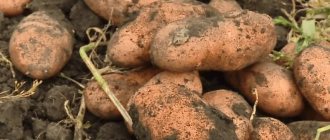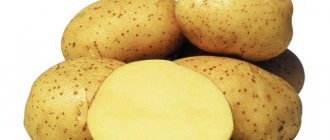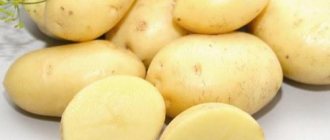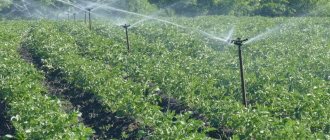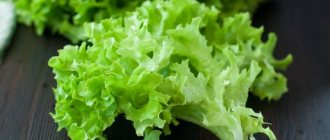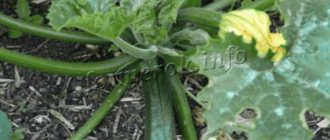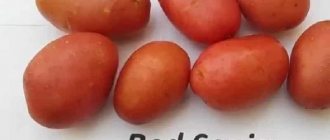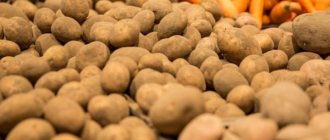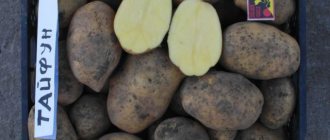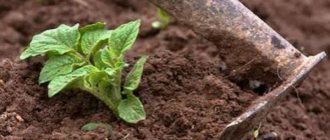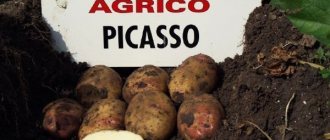Description of the variety
The mid-season potato variety Sineglazka not only has an amazing name, its tubers have interesting features.
Agrotechnicians call this type of potato mid-season. The plant ripens in 90-110 days, does not require any hassle, while guaranteeing owners of acres a consistently high harvest. When creating a new potato variety, which people lovingly called Sineglazka, breeders used several species. According to the plan, the southern regions and central Russia were to become the places for its cultivation. Having heard about the Sineglazka potato, which was ready to give a head start to Dutch hybrids, gardeners began to grow Sineglazka potatoes in the cold northern regions - under film. The first steps yielded good results; over the years, the Sineglazka variety adapted to low temperatures and settled there forever.
One of the main differences between potatoes is their good root system. Spreading bushes with medium-sized bright green leaves, delicate lilac flowers and a yellow center. The tubers of the Sineglazka potato are large, their weight can reach 200 g, round and flattened on the sides. The skin of Sineglazka is slightly rough. Blue eyes are visible on root vegetables.
The plant is comfortable on light loam, sandy and sandy loam soils. Harvest begins in late August or early September. But you can dig up Sineglazka for food starting in July. From one hundred square meters, plot owners dig up to 500 kg of root crops.
Harvesting and storage
If it rains during the potato harvest, you need to wait a little. It is preferable to dig up Sineglazka in dry weather, having previously mowed the tops at a height of 10 cm from the soil level 10 - 14 days in advance. Thus, the outflow of nutrients from the tubers will stop, which will improve ripening.
It is best to dig up potatoes from the row-spacing side. To dig, you need to use a pitchfork, this will reduce the risk of damaging the potatoes. The harvested crop is left for a couple of hours in the fresh air so that the tubers dry out properly. The potatoes are then transferred under a shed and sorted. Damaged tubers are left for consumption, and the rest of the harvest is laid out in boxes and sent to a dark room with a temperature of 15 - 180C. Within a month, the skin of the potato hardens and its taste improves. After this, the tubers are sent to a place of permanent storage at an average temperature of 20C and a humidity of 85 - 90%.
The storage facility must be equipped with a ventilation system. During storage, potatoes are periodically sorted, cutting off sprouts and removing rotten tubers. Small and medium potatoes are first used for food, and then large tubers.
Sineglazka potatoes can be stored in small quantities almost all winter
Origin of the Sineglazka potato
The history of the origin of potatoes with the original name is shrouded in myths.
In reality, everything is much simpler. The new species was created by workers of an experimental station located in the Smolensk region, from cultural forms and wild animals. The author of the variety is called S. Domina. Although his experiments were not crowned with mass success - Sineglazka is not included in the State Register of the Russian Federation, but this does not make it less popular than its relatives. But the name for the potato was invented by the breeder who conducted the testing - Boris Nazarenko. Volunteers who were given seed material noted the good keeping quality of potatoes despite low storage volumes, their taste, productivity and ease of care. But the industrial space for Sineglazka potatoes, which turned out to be picky about long-term storage, has become prohibitive. After several years of testing and unsuccessful attempts to expand the space, the experiment participants decided to recommend Sineglazka for cultivation only in personal plots.
Surprisingly, not all amateur gardeners know that the Sineglazka potato has an official name - “Hannibal”. So he was named in honor of Abram Hannibal, the ancestor of the poet Alexander Pushkin. The Arab Peter the Great, distinguished by his dark skin, is considered the first breeder in Russia.
Varietal characteristics
The description of the Sineglazka potato variety should begin with its features: this potato has an average ripening period and a very extended growing season. The first harvest of young tubers can be harvested at the end of June, and potatoes can remain in the ground until September.
The characteristics of the Sineglazka potato variety are as follows:
- the ripening period ranges from 85 to 100 days;
- potato bushes are powerful, quite tall, spreading;
- the shoots are thick, the root system is highly developed;
- the growth of green mass is abundant;
- leaves are medium-sized, dark green;
- Sineglazka's inflorescences are small and light blue;
- berries with seeds are rarely formed on bushes;
- Potatoes prefer light, sandy, nutritious soil; they bear fruit poorly on heavy and dry soils;
- the yield of the Sineglazka variety is high - about 500 centners per hectare;
- in each bush from 8 to 12 tubers ripen;
- large potatoes, average tuber weight – 170 grams;
- the shape of the potato is oval, slightly flattened;
- the tubers are colored pinkish-gray;
- the eyes are shallow, there are few of them, painted in a blue-lilac tint
- the pulp is white, dense;
- percentage of starch – 15%;
- Sineglazka tubers are considered very nutritious and are suitable for dietary nutrition;
- the taste of potatoes is high - the Sineglazka variety produces aromatic and tender puree; these potatoes are suitable for frying, stewing, preparing salads and any other dishes;
- the Sineglazka potato variety shows resistance to common diseases of nightshade crops (potato canker, late blight, nematode, scab);
- the skin on the tubers is quite thin, so they can be damaged by wireworms - the larvae of the click beetle;
- Blue-eye quickly degenerates, losing its strong qualities, so farmers should not use their own material for planting for several years in a row;
- The Sineglazka harvest is stored poorly, especially in large quantities - most of the tubers are affected by rot;
- For successful storage, potatoes must be placed in small wooden boxes and placed in a spacious dry cellar;
- The yield of Sineglazka and the quality of tubers are highly dependent on weather conditions and soil composition.
Article on the topic: Potato variety “Kamchatka” - description and photo
Varietal qualities are fully preserved only in potatoes grown from seeds. In order to grow high-quality Blue-Eyed, which maintains productivity, taste and immunity to disease, it is necessary to regularly update the planting material.
Advantages and disadvantages
Sineglazka would not have maintained its popularity for such a long period of time if it did not have strong qualities. Reviews from summer residents and gardeners about this potato are the most positive - Russians love the Sineglazka variety and are in no hurry to change it to more modern hybrids.
The advantages of the domestic potato variety are as follows:
- excellent taste, pronounced potato taste and aroma;
- wide culinary possibilities (you can cook anything from Sineglazka);
- immunity to the most common infections of nightshade crops;
- large tubers of even shape and beautiful appearance;
- thin peel and superficially located few eyes;
- large growing area;
- high yield.
Among other advantages, people note the greater resistance of Sineglazka to the Colorado potato beetle compared to other popular potato varieties. However, this information has not been officially confirmed.
The Hannibal variety also has disadvantages, which is why this potato is not planted on an industrial scale. Farmers note the following disadvantages:
- rapid and obvious degeneration of planting material;
- shortage of quality seeds on sale;
- unsuitability of tubers for storage;
- possibility of damage to potatoes by wireworms.
Due to the listed shortcomings, they are trying to replace the Sineglazka potato with new, more modern analogues. In recent years, several varieties of potatoes similar to Sineglazka have appeared. The Dubravka potato is called the most popular and successful: the tubers are just as tasty and beautiful, and also have excellent keeping quality.
Many gardeners do not know how to choose the right Sineglazka potatoes for planting and how to propagate them - for this reason, negative reviews about the variety may appear. The fact is that the Hannibal variety produces very few fruits, and collecting seeds from the bushes is problematic. Therefore, propagation and renewal with your own seeds is almost impossible. The best option is to look for agricultural firms that sell seed potatoes that retain varietal characteristics.
Advantages and disadvantages
Each potato variety has its own advantages and weaknesses. In the case of Sineglazka potatoes, which are called folk potatoes, they are divided almost equally. Among the advantages are noted:
- high productivity;
- the presence of vitamins and minerals in tubers;
- resistance to viruses;
- suitability for wide use in cooking.
Among the disadvantages are:
- unsuitable for long-term storage;
- inability to purchase seed material;
- mandatory regular renewal of planting material.
Planting and caring for Sineglazka potatoes
Before you start planting, you need to prepare the tubers - germinate them. As a rule, by the end of spring, provided they are in the cellar, the root crops themselves are covered with sprouts.
The soil is taken care of in advance. Blue-eye thrives in light, loose soil with neutral acidity. The plant also loves sandy soils, but they will require more frequent watering and an increase in minerals from the owner.
If you are unlucky with the soil on the site, the situation is corrected with the help of manure, sand and humus. It will take more care, but the results are worth it.
Traditionally, the soil is prepared in the fall, freeing it from plant residues. It is recommended to spread manure or humus over the surface. They dig up the ground under Sineglazka with a shovel, removing old weeds from the soil, while trying not to break up huge clods of earth. The fact is that by that time the upper layers of the soil are already occupied by pests. In winter they will die from the cold. As for the clods, under the influence of winds they disintegrate on their own.
Planting of Sineglazka potatoes begins in May. The weather will tell you whether it will be the beginning of the month or its middle. The signal for work is the blossoming birch buds and the soil, which has warmed up to 9 degrees.
Mark the distance between the holes, it should be standard, no more than 30-40 cm. Plant in a checkerboard pattern. The gap between the rows is 70 cm. Potatoes of the Sineglazka variety love sunlight and flat areas. The plant reacts poorly:
- to drafts;
- excess moisture in the soil;
- lack of light.
The first hilling is done when the plant rises 15-20 cm above the ground, the second time after 2-3 weeks. Potatoes of the Sineglazka variety do not need frequent watering. During the growth period, the plant is watered 3-4 times:
- first watering - after germination;
- the second - at the beginning of flowering;
- the third - before its end.
The only reason for more frequent watering can be drought. After flowering ends, it is not recommended to water Sineglazka potatoes.
Features of cultivation
The Sineglazka variety is considered unpretentious. For full growth, the bushes practically do not require watering. Enough liquid obtained from precipitation. If they are missing, the bushes should be watered. For each plant use 4-5 liters of water.
Potatoes do not tolerate stagnant liquid. Therefore, the soil around the bushes needs to be loosened. At the same time, it is cleared of weeds.
Nitrogen fertilizing is carried out only at the stage of bush formation. Fertilizer is applied once 3-4 weeks after germination. During the formation of tubers, you can feed the plants with wood ash.
To increase productivity, it is recommended to hill up the Sineglazka potato bushes. The procedure is carried out twice during the entire growing season.
Diseases and pests
Amateur gardeners note the ability of the Sineglazka potato variety to resist viruses and diseases such as nematodes, scab, and late blight; it has a fairly strong immune system. But it’s worth emphasizing right away: this applies to updated planting material. As soon as the owner of the dacha starts the renewal process, the root crops become vulnerable to many potato diseases. What should land owners be wary of? Protect your garden beds:
- from Colorado potato beetles, which destroy the tops and weaken the plant;
- from click beetles, which damage tubers, turning them into easy prey for microbes.
How to deal with pests? The key term for amateur gardeners at all times has been the word “prevention”. As a rule, it begins long before the potatoes are planted.
With clear organization, this will not cause additional trouble and is done unnoticed. Are you getting ready to plant Sineglazka potatoes? Treat it before planting with growth stimulants and special chemicals, add dry mustard to each hole.
During the growing season, remove weeds - they become sources of viruses. If potatoes are damaged by a fungus or attacked by Colorado potato beetles, treat them with insecticides and fungicides.
Have you harvested? Don't rush to leave the area. Check to see if there are any tubers left in the ground. In winter they will begin to rot, creating favorable conditions for bacteria.
Agricultural technology
If you grow potatoes from high-quality planting material obtained from seeds and not contaminated with viruses and bacteria, you can be sure of the result - Sineglazka will not let you down.
Of course, this potato, like the others, prefers loose soils rich in fertilizers; it requires watering, weeding and cultivation. But, as practice shows, even in unfavorable weather conditions and with minimal agricultural technology, the varietal Sineglazka will give a good harvest.
Planting and care
Hannibal tubers must be planted in the second half of April or early May. The exact time of planting is calculated so that the sprouted bushes do not freeze during the May frosts (the timing is individual for each region).
Caring for potato bushes is not difficult, but it must be done - lack of attention will greatly affect the quantity and quality of the harvest. The rules for caring for Sineglazka are simple:
- These potatoes require moderate watering - the soil is moistened no more than five times during the season. Often, natural precipitation is enough for potatoes to grow normally.
- The soil must be loosened, and spreading bushes must be hilled. To protect the tubers from overheating and the soil from drying out, it is recommended to use mulch.
- Feeding for Sineglazka is very important. This large potato prefers root feeding with organic fertilizers, such as slurry or bird droppings diluted in water. Mineral fertilizers in the form of ammonium nitrate, superphosphate or ammonium sulfate are also effective. You should not be overzealous with nitrogen, it will only increase the green mass.
- Potatoes grown from seeds will remain resistant to diseases for the first couple of years. Subsequently, chemical treatments cannot be avoided, and it is recommended to treat not only the bushes, but also the tubers and the soil before planting. To protect potatoes from wireworms, which can harm the appearance of the tubers, you should spray the plants with insecticides against the click beetle.
- The best taste is observed in the blue-eye at the end of August. It is during this period that it is recommended to harvest these potatoes. Immediately after digging, the tubers must be dried in the fresh air, so they are left in the open air for 3-5 hours. If the weather is rainy, the crop is laid out to dry under a canopy.
Reviews
“Our family has been growing Sineglazka potatoes for 40 years; our passion for the variety began with our parents. They taught how to collect seeds and store them. So we plant in two ways: seedlings and sprouted tubers. I can’t say which method is better. I recommend using both. After planting, you need to water the soil, and when it dries, loosen it. The same applies to Sineglazka seedlings, which are immersed in the soil up to the first leaves,” Anna Berezhnaya, Rostov-on-Don.
“We have loved the Sineglazka potato for a long time, we cherish it as a treasure and always share planting material. This is the only way to continue the lineage of the famous potato. We try to update planting material every five years. Boil the potatoes and fry them. My children grew up on it, and I feed my grandchildren,” Maria S., village. Maksatikha Tver region.
“We value the Sineglazka potato, so we collect all the advice about it. I share my experience on how to germinate. Place the potatoes in two layers on the floor. Choose a room that is dry, bright, and without drafts. From time to time, turn over and discard rotten tubers with thin sprouts. I’ll say it as a long-time gardener: You should definitely have Blue-Eyed, you won’t find a tastier potato. Plant little by little, it’s easier to preserve,” Ivan Zaitsev, Podolsk.
